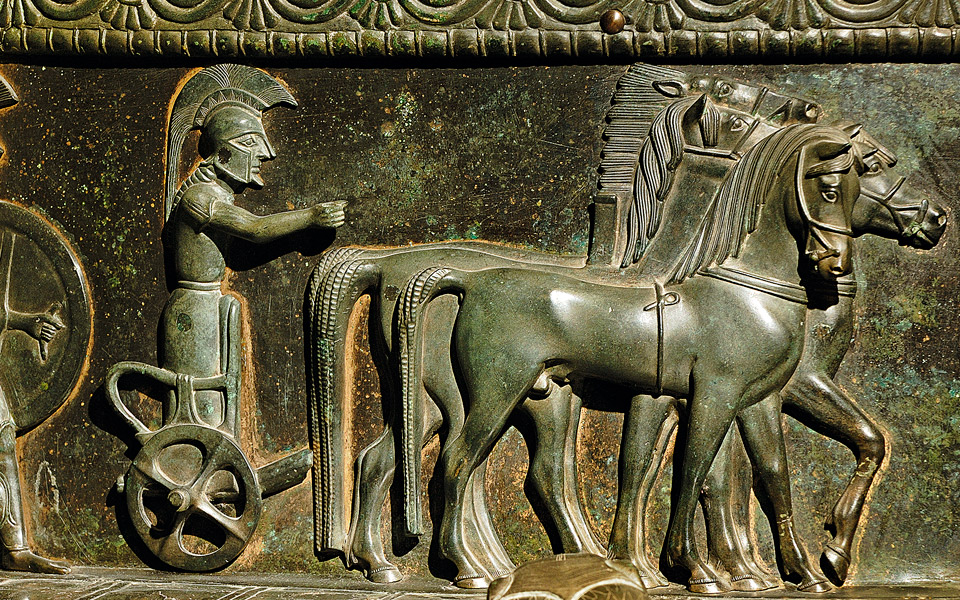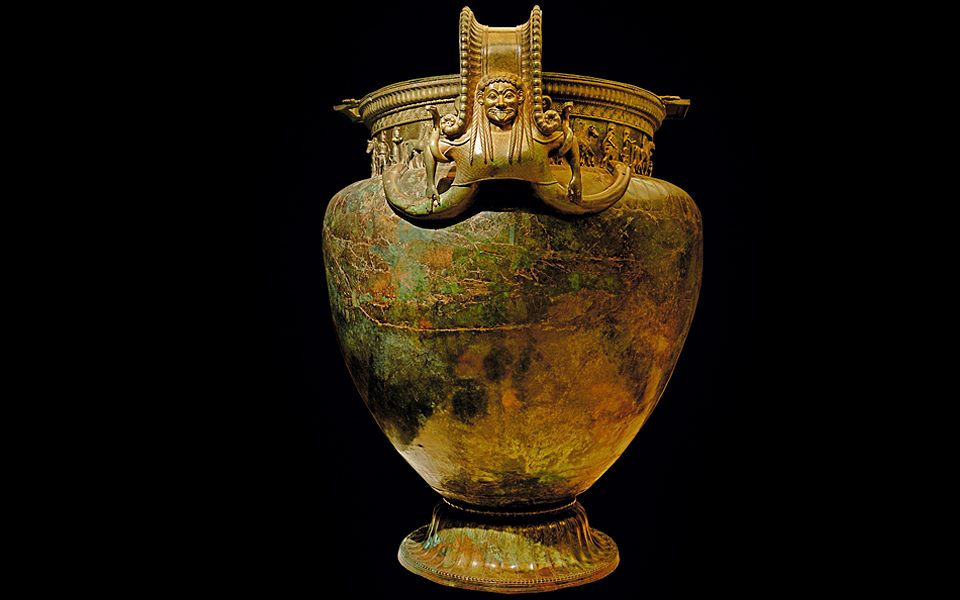The Vix Krater represents one of the most impressive monuments to the expansion of the ancient Greek wine trade known today. A giant bronze crater or mixing vessel, in which wine was blended with water before being served at symposia (drinking parties), the Vix Krater stands 1.64 m tall, weighs 208 kilos and had a capacity of 1,100 liters. With two curving volute-like handles that rise above the rim, the Vix Krater closely resembles in form the much smaller François Vase (66 cm; Archaeological Museum of Florence) and Derveni Krater (90.5 cm; Thessaloniki Archaeological Museum). Its Late Archaic decoration (ca. 530-520 BC) is lavish: two Gorgons with serpentine legs grimace from the base of the handles; a procession of Greek hoplite warriors in full armor march or drive horse-drawn chariots in a sculpted frieze below the rim; a small female figure, perhaps a goddess, wearing a peplos and veil, serves as the handle of the concave lid – which is perforated with tiny holes to allow the straining of the wine as it was poured into the crater. Where is this stunning specimen of ancient Greek, wine-related art? In the depths of central-eastern France, about 240 km southeast of Paris, housed in the new museum of Châtillon-sur-Seine.
The Vix Krater stands 1.64 m tall, weighs 208 kilos and had a capacity of 1,100 liters.

© Corbis/Smart Magna
Discovered in late 1952 by a French farmer and excavated by archaeologist René Joffroy, the Vix Krater turned out to be the centerpiece of a vast array of extraordinary objects that accompanied the burial of a mysterious woman (ca. 500 BC), whose identity is still debated among specialists. In addition to the possibly Spartan crater itself, a number of other artifacts were found, including two wine cups (one silver; one Black-Figure from Attica); a bronze Etruscan wine pitcher (oinochoe) and various finger rings; many wine amphorae from Massalia (Marseille) and other nearby Greek emporia; a shallow silver bowl (phiale) of perhaps local origin; Baltic amber necklaces and a bracelet; as well as an ornate neck ornament (torc) of 24-carat gold, weighing 480 grams, which likely came from an eastern Greek or Syrian workshop.
Whether a princess, noblewoman, wealthy merchant’s wife, or ill-fated sacrificial victim, the Lady of Vix’s expensive, imported funerary offerings, found at a Celt-ruled control point between commercial routes that followed the Seine, Loire and Saone/Rhône rivers, attest to the far reach and inherent value of the international trade in wine and other eastern goods. In exchange, Greek traders took home western goods that included furs, amber, wood and especially tin from Cornwall, an essential material required by ancient Greece’s bronzesmiths. And France, of course, off whose Mediterranean coast thousands of ancient shipwrecks and tens of thousands of lost wine amphorae have been discovered, went on to become one of the world’s great wine-producing centers.
The Vix Krater turned out to be the centerpiece of a vast array of extraordinary objects that accompanied the burial of a mysterious woman (ca. 500 BC), whose identity is still debated among specialists.










